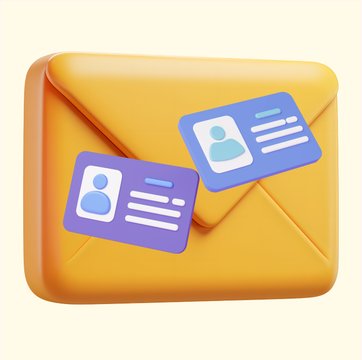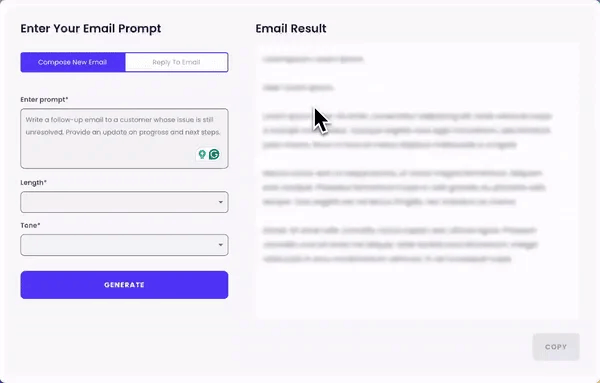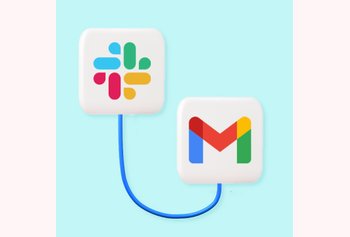How to Write an Effective Formal Email: Format, Tips, and Examples

Table of contents
Ever found yourself struggling to write a formal email? We’ve all been there.
Whether you’re writing to a customer, vendor, employee, colleague, or senior management, the way you present yourself can really impact your professional relationship.
For example, just recently I had to shoot a mail to the IT department of my company to report issues with my device.

Notice how the information that I’m trying to include, the tone, and the formatting is on point? It informs the recipient about the urgency of the matter and expected next steps without overwhelming them.
If you also want to draft professional emails without thinking too hard, I am sharing 7 tips below that can help you ace formal communication. These tips will not only help you communicate with stakeholders effectively but also get the job done.
Let’s dive in.
Table of Contents
- What is a formal email?
- Breaking down the format of a formal email?
- How to write a formal email: 7 Tips
- More examples of formal emails
- 8 Common Mistakes to Avoid When Writing Formal Emails
- Checklist for Proofreading a Formal Email
- How to Use AI to Write Formal Emails
- Write professional emails on the go
What is a formal email?
A formal email is a type of email typically used in professional or official contexts. It is used for professional communication, such as business inquiries, job applications, official notifications, or correspondence with clients, colleagues, or superiors.
The language used in formal emails is usually polite, professional, and free of slang or informal expressions. The tone is respectful and neutral, aiming to convey information or requests clearly and straightforwardly.
Here’s what a formal email looks like:-
Example of a job application email
Subject Line: Request for Meeting to Discuss Q3 Marketing Strategy
Dear Ms. Johnson,
I hope this email finds you well. I’m writing to request a meeting to discuss the upcoming changes to our project timeline.
I would like to schedule a meeting at your earliest convenience to review the revised project timeline and ensure all team members are aligned with the new deadlines. Please let me know your availability next week.
I have attached the updated project plan for your review. Thank you for your attention to this matter. I look forward to your response and hope we can arrange a suitable meeting time.
Sincerely,
John Doe
Marketing Manager
XYZ Corporation
Email: [email protected]
Phone: (123) 456-7890
Breaking down the format of a formal email?
In a formal email, the structure is essential for clarity and professionalism. Here’s a standard format you can use:
Subject Line:
- Clearly states the purpose of the email.
- Example: “Meeting Request: Project Update Discussion”
Salutation:
- A polite greeting that addresses the recipient by their title and last name if known, or a general salutation if not.
- Example: “Dear Mr. Smith” or “To Whom It May Concern”
Opening Paragraph:
- Briefly introduce yourself (if necessary) and state the purpose of the email.
- Example: “I hope this message finds you well. I am writing to inquire about…”
Body:
- Detailed information, organized into clear paragraphs.
- Address the main points of your message, providing necessary details or context.
- Be concise and focused, avoiding unnecessary jargon or lengthy explanations.
Closing Paragraph:
- Summarize the main point, express appreciation, or indicate any next steps.
- Example: “Thank you for your attention to this matter. I look forward to your response.”
Closing:
- A polite sign-off followed by your name.
- Typical closings include “Sincerely,” “Best regards,” or “Yours faithfully,”
- Example: “Sincerely, [Your Name]”
Signature:
- Include your full name, job title, company name, and contact information. Check the example below for reference.

Attachments (if any):
- Mention any attached files in the body of the email.
- Example: “Please find the attached report for your review.”
- This format helps ensure your email is clear, professional, and easy to read.
Recommended Reading:119 Email Phrases to Help You Get the Desired Response
How to write a formal email: 7 Tips
For some people, writing professional emails comes naturally. But for those who find it difficult to draft such emails, here are some tips you can apply the next time you write an email to a customer, vendor, or colleague.:
1. Craft a Clear Subject Line
Remember to use a clear subject line in your email. A clear subject line helps the recipient understand the email’s purpose and decide how to prioritize it. It sets the tone for the email and determines whether or not the recipient will open it.
Some examples of formal subject lines include:
- Request for Meeting to Discuss [Topic]
- Application for [Job Title] Position
- Follow-Up: [Specific Topic or Meeting]
- Confirmation of Appointment on [Date]
- Inquiry Regarding [Project/Topic]
- Important Update: [Subject Matter]
- Proposal for [Project/Collaboration]
- Reminder: Upcoming Deadline for [Task/Project]
- Thank You for Your Assistance
- Feedback Request on [Document/Report]
Pro Tip: If the matter requires immediate attention, using “urgent” in the subject line can help convey the seriousness of the situation. For example, “Urgent: Immediate Action Required for Compliance Issue.”
2. Use a polite salutation
A polite salutation in a formal email is essential for setting a professional tone and respecting the recipient. Unless you have an established relationship or have been invited to use their first name, stick to their title and last name—for example, Dear Professor Brown.
Also, keep in mind these two scenarios:
- If you know the recipient’s name: “Dear Mr. Smith,”
- If you don’t know the recipient’s name: “To Whom It May Concern,”
Pro Tip: If you are unsure of the recipient’s gender or prefer a gender-neutral approach, you can use “Dear Taylor Jordan” or “Dear Alex Morgan.”
3. Write a strong opening paragraph
Start your email with a polite greeting. If you are writing to someone for the first time or someone who may not know you well, briefly introduce yourself and your position. Then, clearly state the purpose of your email. Avoid unnecessary details at the start and focus on why you’re writing the email.
For example:-
“Dear Ms. Johnson,
I hope this email finds you well.
My name is Jane Doe, and I am the Marketing Manager at XYZ Corporation.
I am requesting a meeting to discuss the upcoming changes to our project timeline.”
More Examples of Strong Opening Paragraphs:
– Introducing yourself:
“My name is John Smith, and I am the new Sales Director at ABC Company. I am writing to introduce myself and to discuss how we can collaborate effectively moving forward.”
– Requesting information:
“I am reaching out to request information on the new software implementation scheduled for next quarter. Your insights would be invaluable in ensuring a smooth transition.”
– Following up:
“I hope this email finds you well. I wanted to follow up on our previous conversation regarding the marketing strategy for Q4.”
– Meeting Request:
“I hope this message finds you well. I am reaching out to request a meeting to discuss Q3 Marketing Strategy. I believe that a brief conversation could help us align our efforts and ensure we are on the same page moving forward.”
– Job Application:
“I am writing to express my interest in the Marketing Specialist position at Gartner, as advertised on LinkedIn. With a background in Marketing and proven experience in Digital Marketing and Strategy, I am excited about the opportunity to contribute to your team.”
– Introduction of Services:
“Allow me to introduce myself; my name is Alex, and I am the Outreach Specialist at ABC Company. We specialize in link building services, and I am eager to explore how we can assist you in achieving your goals.”
4. Be clear and concise in the body of your email
Break your email into distinct paragraphs, each focusing on a single point or idea. This makes your email easier to read and understand.
You can follow this structure:
- Paragraph 1: State the main point or request.
- Paragraph 2: Provide any necessary details, background information, or context.
- Paragraph 3: Offer a solution or propose the next steps.
Consider usingbullet points or numbered lists if you have several points to make. Avoid adding irrelevant details that may confuse the recipient.
For example,instead of writing, “As you know, the meeting is an important part of our project planning and will include various stakeholders,” you could say, “The meeting is crucial for project planning and will include key stakeholders.”
Additionally, mention any actions you want the recipient to take. Make sure to include deadlines if applicable.
Example body:
I am writing to update you on the progress of our marketing campaign for Q3.
As discussed in our last meeting, we have implemented the following strategies:
- Launched a targeted social media campaign that has increased engagement by 15%.
- Expanded our email marketing list, adding 1,000 new subscribers.
- Partnered with local influencers to increase brand visibility.
To maintain this momentum, I recommend the following next steps:
- Increase the budget for social media ads by 20%.
- Schedule a follow-up meeting with the content team to brainstorm new blog topics.
- 3.Review the current email campaign metrics and adjust the strategy.
Please let me know if you agree with these recommendations or have additional suggestions.
5. Conclude with a Polite Closing Paragraph
The purpose of a closing paragraph is to summarize the email and express appreciation.
If your email contains multiple points or requests, briefly recap them in the closing paragraph to reinforce your message. For instance, “I would appreciate your feedback on the report and confirmation for next Tuesday’s meeting.” A simple “Thank you for your time and consideration of this request ” goes a long way.
For example, “Thank you for your attention to this matter. I look forward to your response and hope we can arrange a suitable time for the meeting.”
6. Include a Professional Closing
Choose a closing phrase that suits the formality of your email. Common options include:
- “Sincerely,”
- “Best regards,”
- “Yours faithfully,”
Example: “Sincerely, John Doe”
7. Add a Signature
Sign off with your full name to maintain professionalism, especially if this is your first time contacting the recipient. Depending on the context, you may include your position, company name, or additional contact details.
For example:
John Doe
Marketing Manager
XYZ Corporation
Email: [email protected]
Phone: (123) 456-7890
You can also use something like this:-

More examples of formal emails
Here are a few examples of formal emails for different scenarios, demonstrating various levels of formality and purpose:
1. Requesting a Meeting
Subject: Request for Meeting to Discuss Q4 Marketing Strategy
Dear Mr. Johnson,
I hope this email finds you well.
I am writing to request a meeting to discuss our Q4 marketing strategy and explore potential areas for improvement. Given the importance of this planning session, reviewing the current metrics and aligning our goals for the next quarter would be beneficial.
Could we schedule a time to meet next week? I am available on Tuesday and Thursday mornings. Please let me know if either of these times works for you or if you have another preference.
Thank you for considering this request. I look forward to your response.
Sincerely,
Jane Doe
Marketing Manager
ABC Corporation
2. Submitting a Report
Subject: Submission of Annual Financial Report
Dear Ms. Patel,
As requested, I am pleased to submit the Annual Financial Report for the fiscal year ending June 2024. The report includes a comprehensive overview of our financial performance and a detailed analysis of key metrics.
Please find the report attached to this email. I would appreciate your review of the document and provide feedback by August 30th.
If you require any further information or clarification, please do not hesitate to contact me. Thank you for your time and consideration.
Yours sincerely,
John Smith
Chief Financial Officer
Innovate Corp
3. Requesting Information
Subject: Request for Information on New Software Implementation
Dear Mr. Clark,
I hope you are doing well.
I am requesting detailed information on the new software implementation scheduled for the upcoming quarter. Specifically, I would like to understand the scope of the project, key milestones, and the support that will be provided during the transition.
Please provide the relevant documentation or arrange a brief meeting to discuss the project in more detail. Your insights would be greatly appreciated as we prepare for this significant change.
Thank you for your time and assistance.
Sincerely,
Rachel White
IT Coordinator
Future Tech Ltd
4. Providing Instructions
Subject: Instructions for Completing the Compliance Training
Dear Team,
I hope this message finds you well.
As part of our ongoing commitment to regulatory compliance, all employees must complete the mandatory compliance training by September 10th. The training modules are available online, and I have attached a step-by-step guide to assist you in completing the course.
Please ensure you finish the training by the deadline, as it is essential to maintain our compliance standards. Should you encounter any issues or have any questions, please contact me.
Thank you for your cooperation.
Best regards,
David Turner
Compliance Officer
Secure Tech Inc.
5. Formal follow-up email
Subject: Follow-Up on Proposal Submission
Dear Mr. Anderson,
I hope this message finds you well.
I am following up on the proposal I submitted last week regarding the [Project Name/Topic]. As the deadline for finalizing the project plan is approaching, I wanted to check if you had the opportunity to review the proposal and whether there are any questions or feedback I can assist with.
Your input is crucial to moving forward, and I am happy to make any necessary adjustments to ensure that the proposal aligns with your expectations.
Please let me know if you require any additional information or if we could schedule a brief meeting to discuss the proposal in more detail.
Thank you for your time and consideration. I look forward to your response.
Best regards,
Emily Johnson
Business Development Manager
ABC Solutions
6. Introduction of Services
Subject: Introduction of Our Services
Dear [Recipient’s Name],
My name is [Your Name], and I am the [Your Position] at [Your Company]. We specialize in providing [brief description of services], and I am reaching out to explore potential collaboration opportunities that could benefit your organization.
I would appreciate the chance to discuss how we can assist you in achieving your goals. Please let me know a suitable time for a brief conversation.
Warm regards,
[Your Name]
[Your Position]
[Your Company]
7. Thank You Email
Subject: Thank You for Your SupportDear [Recipient’s Name],
I wanted to take a moment to express my gratitude for your support during [specific event or project]. Your guidance was instrumental in achieving our goals, and I truly appreciate your contributions.
Thank you once again, and I look forward to working together in the future.
Best regards,
[Your Name]
[Your Position]
[Your Company]
8. Notification of Change
Subject: Notification of Change in Schedule
Dear Team,
I hope this email finds you well. I am writing to inform you that there has been a change in our meeting schedule. The meeting originally set for [original date and time] will now take place on [new date and time].
Thank you for your understanding, and please let me know if you have any questions.
Sincerely,
[Your Name]
[Your Position]
[Your Company]
9. Reminder Email
Subject: Reminder: Upcoming Deadline for Submission
Dear [Recipient’s Name],
I hope you are doing well. This is a friendly reminder that the deadline for submitting [specific document or task] is approaching on [deadline date]. Please ensure that all necessary materials are submitted by this date.
Thank you for your attention to this matter.
Best regards,
[Your Name]
[Your Position]
[Your Company]
10. Proposal Submission
Subject: Submission of Proposal for [Project/Service]
Dear [Recipient’s Name],
I am pleased to submit our proposal for [Project/Service], which outlines how we can assist [Client/Company Name] in achieving its objectives.
Attached to this email is the detailed proposal document for your review. I look forward to discussing this proposal further and exploring how we can work together effectively.
Warm regards,
[Your Name]
[Your Position]
[Your Company]
8 Common Mistakes to Avoid When Writing Formal Emails
When crafting a formal email, the stakes can feel high. That’s why it’s important to recheck and avoid any mistakes including, typos, missing attachments, and or wrong links, etc.
Here some things you must avoid when drafting a formal email:-
1. Vague Subject Lines
A subject line should clearly indicate the email’s purpose. Avoid vague phrases like “Quick Question” or “Important Update.” Instead, use specific subject lines such as “Question Regarding Q4 Marketing Budget Allocation” or “Update on Project Timeline.”
2. Overly Complicated Language
Using jargon or complex language can alienate the recipient. For example, instead of saying, “We need to synergize our core competencies,” opt for simpler language: “Let’s work together to improve our main skills.” This makes your message more accessible and easier to understand.
3. Ignoring Grammatical and Spelling Errors
Frequent mistakes can undermine your credibility. For instance, ensure you don’t confuse “their,” “there,” and “they’re.” Always proofread your emails; tools like Grammarly can help catch errors before you hit send.
4. Excessive Length and Lack of Structure
Long emails are often skimmed or ignored. Aim for brevity—ideally between 50 to 125 words—and use bullet points for key information. For example, instead of writing a lengthy paragraph about project updates, list them clearly:
- Update on project timeline
- Budget adjustments
- Next steps
5. Attaching Files Incorrectly
Ensure that any attachments are correctly included before sending the email. A common mistake is mentioning an attachment in the body but forgetting to attach it. Always double-check that files are attached and appropriately named (e.g., “Q4_Report.pdf” instead of “Document1.pdf”).
6. Lack of Clarity in Requests or Next Steps
Be explicit about what you need from the recipient. Instead of saying, “Let me know what you think,” specify: “Could you please provide your feedback by Friday?” This clarity helps the recipient understand their responsibilities and deadlines.
7. Inappropriate Use of CC and BCC
Using CC (carbon copy) and BCC (blind carbon copy) improperly can lead to confusion or privacy issues. Only CC individuals who need to be in the loop and use BCC for large distribution lists to protect recipients’ email addresses. For example, if you’re sending a project update to a team, CC relevant stakeholders but BCC external contacts.
8. Failing to Set a Clear Timeline
When requesting actions from others, specify a clear timeline to avoid ambiguity. Instead of saying, “Please get back to me soon,” try “Could you please respond by end of day Wednesday?” This helps prioritize tasks and manage expectations.
Recommended Reading:10 Tips and Tools I Recommend to Improve Email Productivity
Checklist for Proofreading a Formal Email
Proofreading your email is a vital step that you definitely don’t want to skip. It helps make sure your message is clear, professional, and free of any pesky errors. Plus, a well-proofread email shows that you pay attention to detail and respect the person you’re writing to.
To make things easier for you, I’ve put together a handy checklist to guide you through the proofreading process before you hit that send button.
Proofreading Checklist
- Check the Subject Line
- Ensure it accurately reflects the content of the email.
- Avoid vague or generic phrases.
- Review the Greeting
- Use an appropriate salutation (e.g., “Dear [Name]” or “Hello [Name]”).
- Make sure you spell the recipient’s name correctly.
- Verify the Tone and Language
- Ensure the tone is professional and respectful.
- Avoid slang, jargon, or overly casual expressions.
- Read for Clarity
- Check if your main points are clear and easy to understand.
- Ensure that your requests or next steps are explicitly stated.
- Look for Grammatical Errors
- Check for subject-verb agreement and proper tense usage.
- Watch out for common grammatical mistakes (e.g., “its” vs. “it’s”).
- Check Spelling
- Use spell-check tools but also manually review for context-specific errors.
- Pay attention to commonly confused words (e.g., “their,” “there,” “they’re”).
- Review Formatting
- Ensure consistent font style and size throughout the email.
- Use paragraphs and bullet points for readability.
- Verify Attachments
- Confirm that any referenced attachments are included.
- Ensure files are appropriately named and relevant to the email content.
- Check CC and BCC Fields
- Ensure that you have included all necessary recipients in CC.
- Use BCC appropriately to protect privacy when emailing large groups.
- Read Aloud
- Reading the email aloud can help identify awkward phrasing or unclear sentences.
- This technique can also assist in catching errors you might miss when reading silently.
- Confirm Contact Information
- Double-check that your signature includes accurate contact information.
- Make sure links (if any) are functional and direct to the correct locations.
- Final Review Before Sending
- Take a moment to read through the entire email one last time.
- Ensure that it aligns with your intended message and purpose.
How to Use AI to Write Formal Emails
Using AI tools to write formal emails can help you craft professional emails in a matter of seconds. These tools leverage advanced technologies like natural language processing (NLP) and machine learning to create tailored email drafts based on user input. When using an AI email writing tool, users typically provide essential details such as the subject of the email, the intended recipient, and the desired tone (e.g., formal, casual, urgent). The AI then analyzes this information to generate relevant content that meets the specified criteria.
Choosing the Right AI Email Writing Tool
- Grammarly: Known for its grammar-checking capabilities, Grammarly also features an AI-powered email writer that helps users create well-structured emails effortlessly. By entering basic details about the email’s purpose, users can receive instant drafts tailored to their needs.
- ToolBaz: This free AI Email Writer is designed for quick email composition without requiring login credentials. ToolBaz supports unlimited usage and offers customizable inputs such as tone and urgency level.
- Superhuman: Known for its speed and efficiency, Superhuman offers features like AI-powered email composition, instant reply drafts, and conversation summarization. It’s particularly favored by power users who handle large volumes of emails.
- Hiver’s Free AI Email Writer: Hiver offers a free AI email writer that allows users to generate clear, professional emails in seconds. Users can specify the type of email they want (e.g., sales pitch or follow-up) and provide key prompts. The AI then generates multiple draft options, enabling users to select the best fit and personalize it further.

Factors to Consider When Selecting an AI Email Writing Tool
- Features Offered: Look for essential features such as drafting assistance, grammar checking, tone adjustments, and template customization.
- User Interface: Ensure the tool is easy to navigate and fits well within your workflow.
- Integration Capabilities: Check if it integrates seamlessly with your existing email client (e.g., Gmail or Outlook).
- Pricing Structure: Compare pricing plans and look for free trials or demos before committing.
- Customer Support: Reliable customer support can help resolve issues quickly.
- Customization Options: The ability to customize templates or responses can save time and improve personalization in your communications.
Steps to Write a Formal Email Using AI
1. Provide Clear Instructions to the AI
To maximize the effectiveness of an AI email writing tool, craft clear prompts:
- Specify the Purpose: Clearly state the email’s reason, such as a follow-up after a meeting.
- Identify the Recipient: Mention who the email is addressed to, as this influences tone and content.
- Define the Tone: Indicate whether you want the tone to be formal, friendly, or assertive.
Example Prompt: “Write a formal follow-up email to a client after our meeting on project updates. The tone should be professional and courteous.”
2. Review and Edit AI-Generated Content
After receiving the draft, review and edit it:
- Importance of Human Oversight: AI-generated content may lack specific nuances. Carefully check for accuracy and appropriateness.
- Check for Clarity: Ensure the email flows logically and key points are clearly articulated.
3. Customize for Personal Touch
Add personal details to make your email more engaging:
- Incorporate Personal Details: Mention relevant information about the recipient or past interactions.
- Add Context: Provide background information to help the recipient understand your message better.
For example, If you’re following up on a meeting about a project, you might add, “I appreciated your insights on the marketing strategy during our discussion last week.”
Recommended Reading: 10 Best AI Email Summarizer Tools [2025]
Write professional emails on the go
In a world where our attention spans are slowly decreasing, it’s essential to communicate smartly and effectively.
That’s why mastering the art of drafting an email in the professional world is a critical skill. The tips, tools, and examples in this guide will help you improve your email writing skills and make a positive impression on your recipients.
But if you are pressed for time, you can check out Hiver’s AI writer. Simply enter a prompt – mention what you want the email to be about and its tone and length – to draft impactful emails in seconds.

































